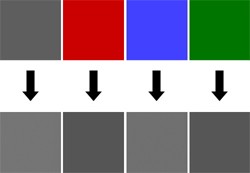|
| Photo tips |
Proper Exposure
We have found that most digital cameras require "Exposure
Compensation" when using studio lighting. Exposure Compensation
provides the ability to influence the auto exposure control
of the camera and allow you to correctly expose an object
especially against a white background.
You will need to experiment with your camera
until you get satisfactory results and them leave the
camera set to the necessary exposure compensation setting.
Exposure can be adjusted several
ways including exposure value (EV), ISO setting and metering.
-
Exposure Value (+/-EV) is the camera's
way to offset exposure by adjusting the shutter speed
and aperture setting. You can also manually
control shutter speed and aperture for the desired
exposure. Use the table below to get a general
idea how EV changes your camera's shutter speed and
aperture.
-
Adjusting the ISO setting can also
be used to adjust the exposure. ISO is a setting for light sensitivity.
ISO 100 is considered the "normal" setting for most
cameras, although some go as low as ISO 50. Higher
sensitivity levels work well in low light conditions
and increase exposure but image quality can become
grainy - something to look out for. Sensitivity
levels can be increased to 200, 400, 800, or even
3,200 on high-end digital SLRs.
-
 Meter settings
change how the camera uses the scene to provide an
18% grayscale exposure. In other words, the
camera's metering system is calibrated to a certain
light value in order to guarantee constant exposure
settings: 18% gray is commonly used in digital
cameras because a typical scene reflects about the
same amount of light as this gray value. For
comparison all these colors shown here reflect
light in average about 18% gray: Usually this assumption
works well but if you expose a scene with a majority
of bright colors/grays without compensation in
spot or center-weighted mode the camera will darken
the photo to an 18% grayscale average - the result
is under-exposure. Most cameras are blind in
regard to colors. Meter settings
change how the camera uses the scene to provide an
18% grayscale exposure. In other words, the
camera's metering system is calibrated to a certain
light value in order to guarantee constant exposure
settings: 18% gray is commonly used in digital
cameras because a typical scene reflects about the
same amount of light as this gray value. For
comparison all these colors shown here reflect
light in average about 18% gray: Usually this assumption
works well but if you expose a scene with a majority
of bright colors/grays without compensation in
spot or center-weighted mode the camera will darken
the photo to an 18% grayscale average - the result
is under-exposure. Most cameras are blind in
regard to colors.
Manual Exposure
Control
Manual control of exposure provides the ability to manage
the aperture of the lens, which is very important for
maximizing "depth-of-field". Small apertures (larger numbers
like f-8 of f-11) are the most desirable settings to maintain
sharp focus over an entire 3 dimensional object. Setting
the camera to manual exposure control or "aperture priority"
will allow for the selection of a small aperture.
When using "aperture priority" the shutter speed will
be selected by the camera and in manual mode by the photographer.
In many cases, with small apertures, the shutter speed
will be slow and a tripod is essential.
|
| |
|
| |
| |
| |
|




